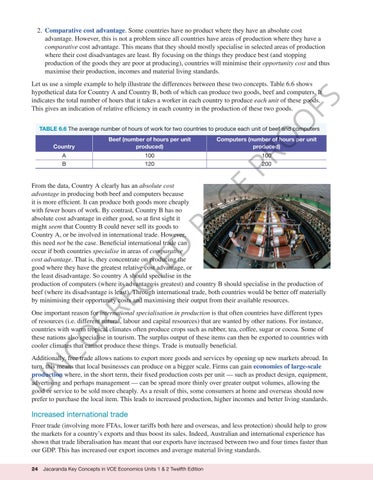“c06TheEconomicsOfInternationalTrade_PrintPDF” — 2022/5/31 — 13:29 — page 24 — #24
2. Comparative cost advantage. Some countries have no product where they have an absolute cost advantage. However, this is not a problem since all countries have areas of production where they have a comparative cost advantage. This means that they should mostly specialise in selected areas of production where their cost disadvantages are least. By focusing on the things they produce best (and stopping production of the goods they are poor at producing), countries will minimise their opportunity cost and thus maximise their production, incomes and material living standards.
O
FS
Let us use a simple example to help illustrate the differences between these two concepts. Table 6.6 shows hypothetical data for Country A and Country B, both of which can produce two goods, beef and computers. It indicates the total number of hours that it takes a worker in each country to produce each unit of these goods. This gives an indication of relative efficiency in each country in the production of these two goods.
Beef (number of hours per unit produced)
A B
100 120
Computers (number of hours per unit produced)
PR
Country
O
TABLE 6.6 The average number of hours of work for two countries to produce each unit of beef and computers
100 200
CO RR EC
TE
D
PA
G
E
From the data, Country A clearly has an absolute cost advantage in producing both beef and computers because it is more efficient. It can produce both goods more cheaply with fewer hours of work. By contrast, Country B has no absolute cost advantage in either good, so at first sight it might seem that Country B could never sell its goods to Country A, or be involved in international trade. However, this need not be the case. Beneficial international trade can occur if both countries specialise in areas of comparative cost advantage. That is, they concentrate on producing the good where they have the greatest relative cost advantage, or the least disadvantage. So country A should specialise in the production of computers (where its advantage is greatest) and country B should specialise in the production of beef (where its disadvantage is least). Through international trade, both countries would be better off materially by minimising their opportunity costs and maximising their output from their available resources. One important reason for international specialisation in production is that often countries have different types of resources (i.e. different natural, labour and capital resources) that are wanted by other nations. For instance, countries with warm tropical climates often produce crops such as rubber, tea, coffee, sugar or cocoa. Some of these nations also specialise in tourism. The surplus output of these items can then be exported to countries with cooler climates that cannot produce these things. Trade is mutually beneficial.
U
N
Additionally, free trade allows nations to export more goods and services by opening up new markets abroad. In turn, this means that local businesses can produce on a bigger scale. Firms can gain economies of large-scale production where, in the short term, their fixed production costs per unit — such as product design, equipment, advertising and perhaps management — can be spread more thinly over greater output volumes, allowing the good or service to be sold more cheaply. As a result of this, some consumers at home and overseas should now prefer to purchase the local item. This leads to increased production, higher incomes and better living standards.
Increased international trade Freer trade (involving more FTAs, lower tariffs both here and overseas, and less protection) should help to grow the markets for a country’s exports and thus boost its sales. Indeed, Australian and international experience has shown that trade liberalisation has meant that our exports have increased between two and four times faster than our GDP. This has increased our export incomes and average material living standards. 24
Jacaranda Key Concepts in VCE Economics Units 1 & 2 Twelfth Edition





















































